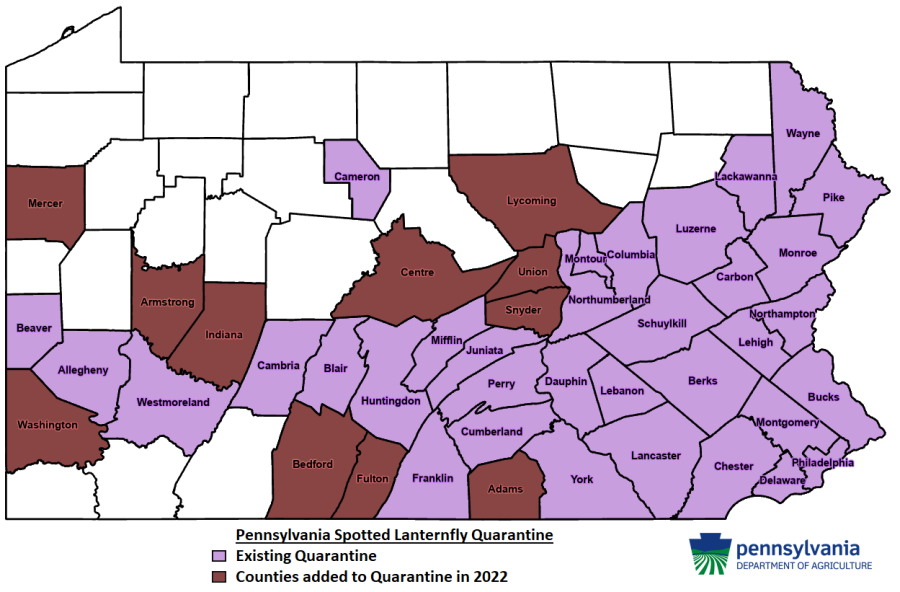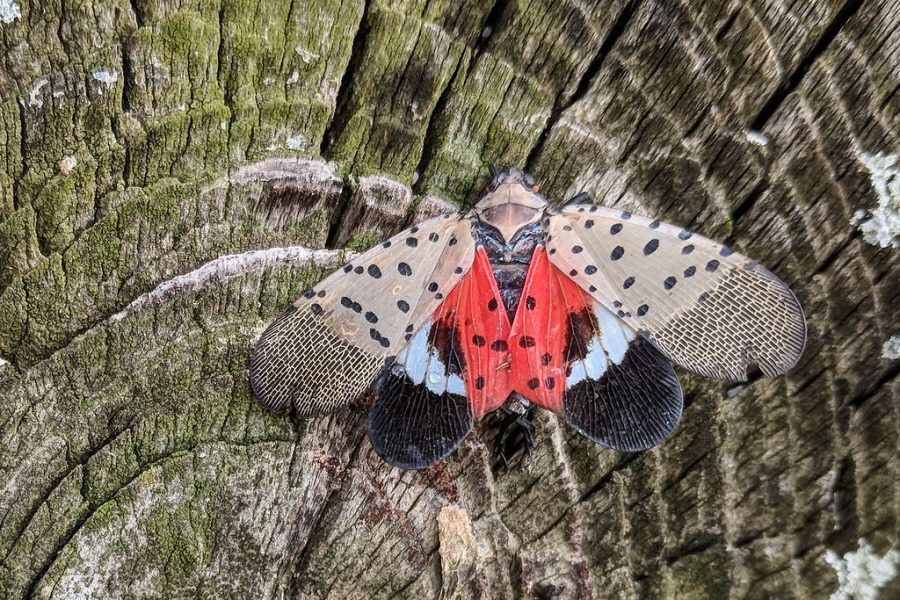Spotted Lanternfly: PA’s Most Wanted
The invasive species has boomed in population across Pennsylvania, creating a threat to nature and infrastructure alike.
In Lancaster County, PA, a spotted lanternfly lands on a tree stump.
Picture this: you’re taking a leisurely stroll on a cool autumn morning. The crisp breeze whips across your face, you admire the vibrant trees, and you can faintly hear the squeaks of squirrels gathering acorns for winter. All of the sudden… CRUNCH! You look down in disgust to find the remains of a large, red fly with black spotted wings.
If this scenario becomes reality for you this summer or fall, don’t feel too bad. You just took out one of America’s most notorious ecoterrorists.
The spotted lanternfly has been swarming the news headlines recently. These invasive bugs originated in China, and through cargo ships, have reached America. While they have been identified across most of the US, the spotted lanternfly population has boomed in western Pennsylvania. You may have seen them at North Park, school, your home, or even Kennywood. Regarding its proliferation, the insect can best be compared to the stink bug, another invasive species we are all too familiar with.
Despite their vivid colors and intricate beauty, these insects present a serious problem to the environment. Most notably, spotted lanternflies have immensely destructive capabilities to plant life. They have been known to ravage crops, kill trees in a short time span, and even suck the life out of sap-producing plants.
As if ruining the flora was not enough, the insect frequently leaves a sticky residue anywhere they land, which further hurts plants and can even damage cars and houses.
To make matters worse, the lanternfly’s bright red coloring is repulsive to most predators. This means that most birds or other insects will not attempt to attack the lanternfly, allowing the population to spread rapidly throughout North America in just a few short years.
Most zoologists and environmentalists would discourage the needless killing of insects, despite how creepy or crawly they may seem. However, the scientific community is actively encouraging people to stomp on these invasive abominations. Staten Island, New York recently hosted its first “Squishathon” where participants would hike to infested areas, and squish every lanternfly in sight.
Taking out spotted lanternflies is both safe and easy. The insect has no defense mechanisms, being unable to bite or sting. In addition, the spotted lanternfly is a poor flier, preferring instead to hop from plant to plant. It can be an easy target to stomp, swat, or squish. For those who prefer a less messy method of extermination, lanternflies can not fly upwards, meaning they can be easily trapped in a plastic water bottle to suffer a slow death.

Mr. Chris Omastis, an environmental science teacher and Science Department Chairperson here at NASH, is currently offering bonus points to any environmental science student who successfully kills a lanternfly and takes a picture of it.
“They do a lot of damage to plants. They can cause sap to ooze, leaves can curl and wilt, and whole sections of the plant can die. At the worst, they can kill entire plants and trees,” Omastis said. “When they feed, they excrete a substance that encourages mold to grow on the plant, which will then also harm the plant. They can cause millions of dollars worth of damage to crops like grapes, apples, or hardwood trees. There could also be other issues in food chains that these bugs could cause that we are not yet aware of.”
Omastis also worries about the damage these bugs can cause to personal property and infrastructure.
“Besides harming plants, the substance that they secrete can get on cars, patios, or houses,” he added. “It is very hard to clean off and can damage paint and leave permanent stains. Every year that they are allowed to multiply will allow them to continue to spread throughout the whole state of Pennsylvania. Each bug can lay 30-50 eggs at a time.”
Omastis also recommends killing the bugs, as well as reporting their location. Students can either call 1-888-4BADFLY or report where they found the bugs online.
“The most important thing is that once you identify one, there are likely others, so finding and killing them in your yard can help to protect your community and keep them from spreading further,” Omastis said. “These aren’t the first or the last invasive species that we will deal with. I hope students can gain an appreciation for how complex systems can be in nature, yet how easily we can disrupt them if we aren’t careful.”

Brady Crow is a senior for the 2023-2024 school year. He's a Co-Editor-in-Chief for the Uproar this year and is excited for the opportunity to write and read many fascinating articles. When not writing for the Uproar, Brady enjoys working at his church, going to the gym, and taking care of his pet lizard.

